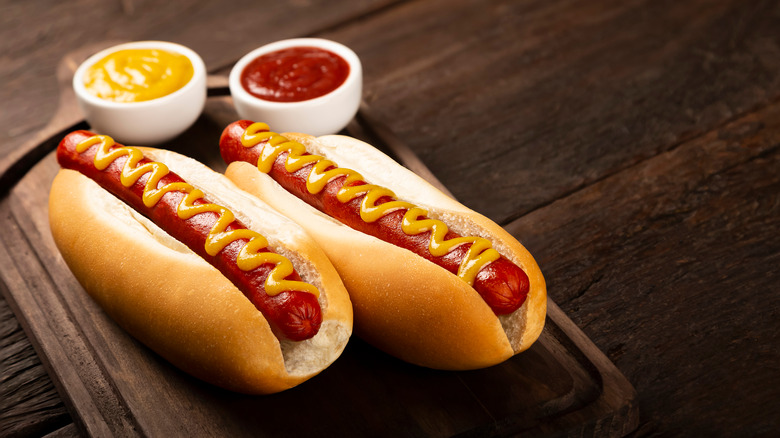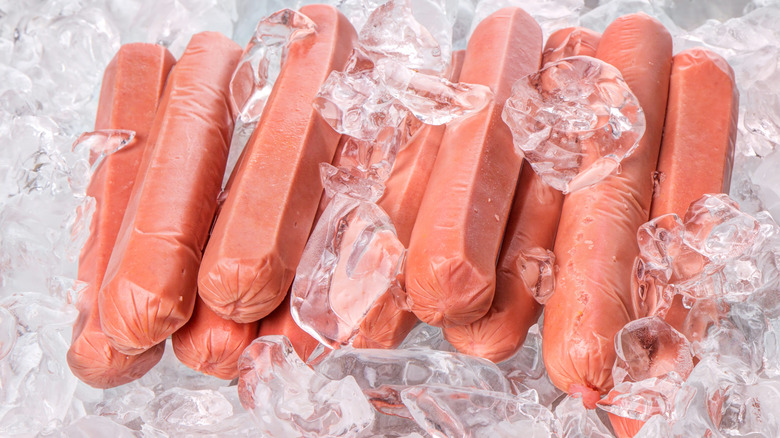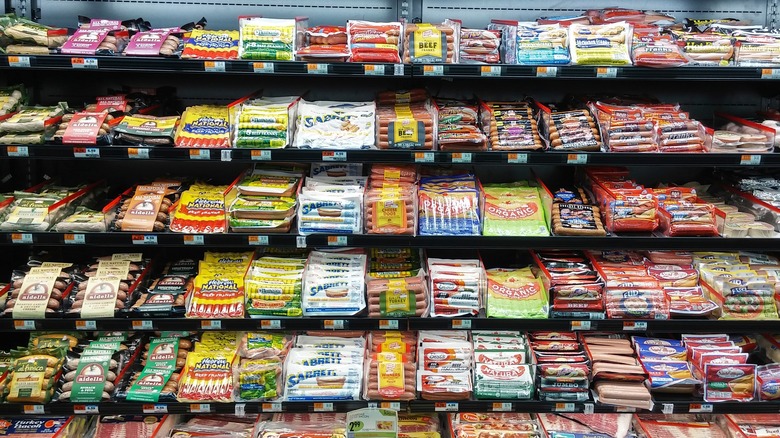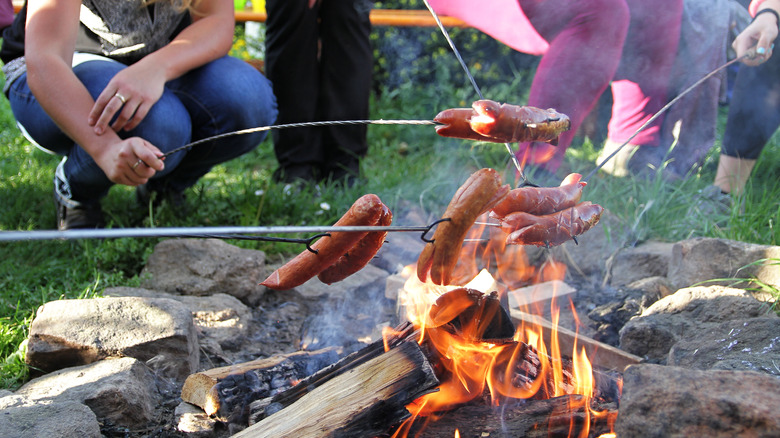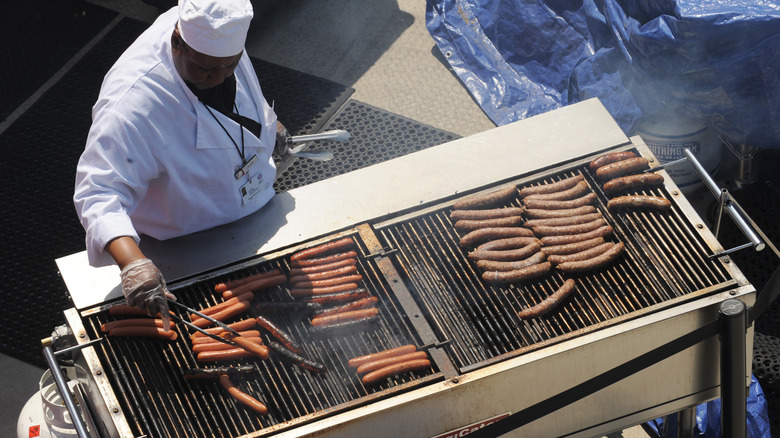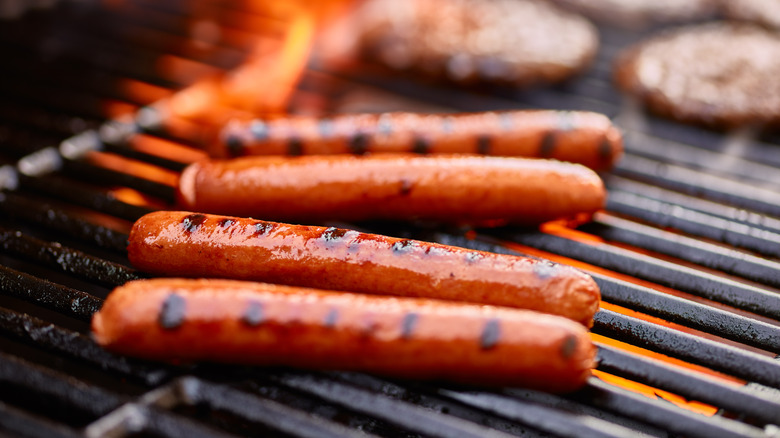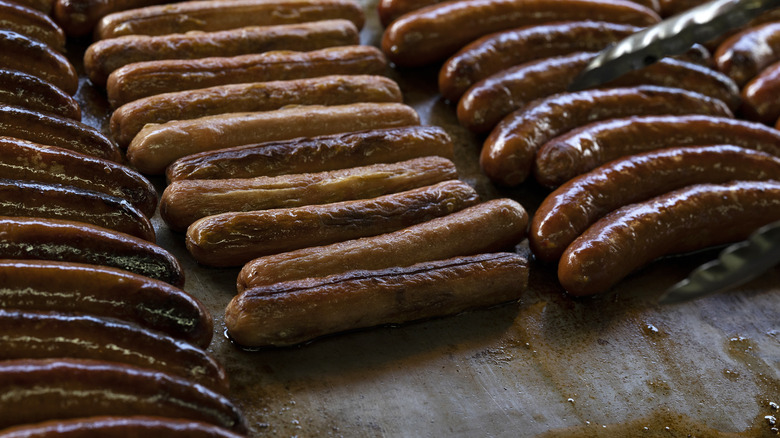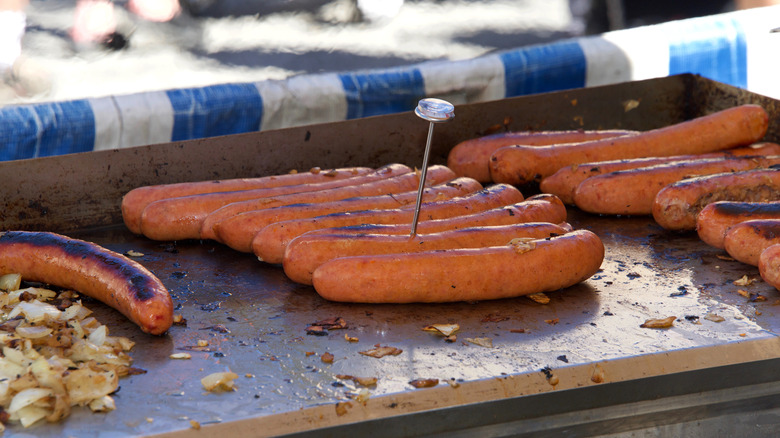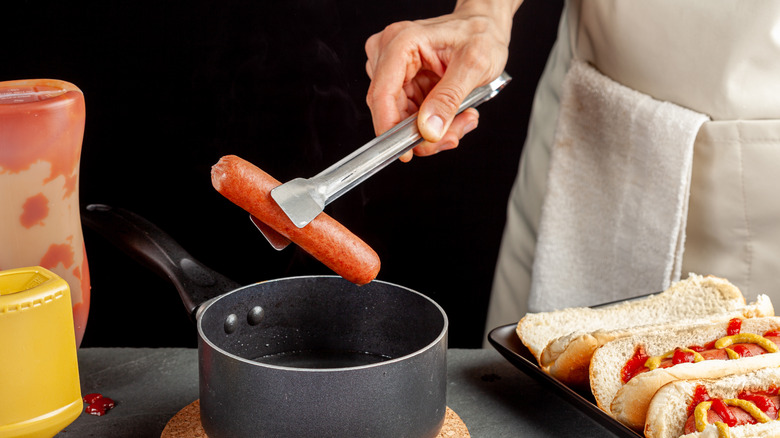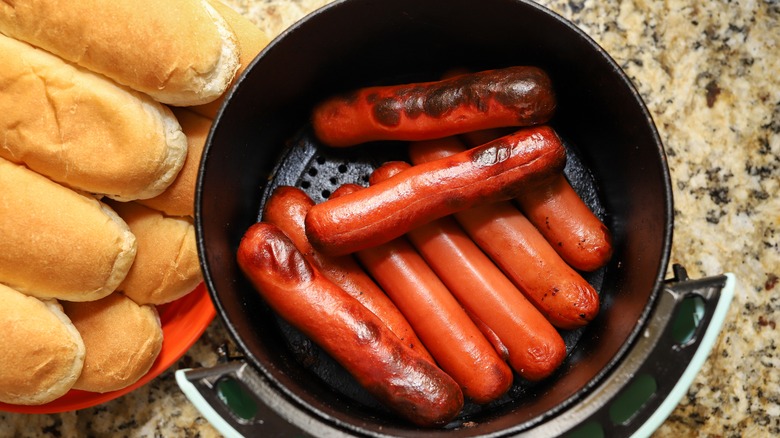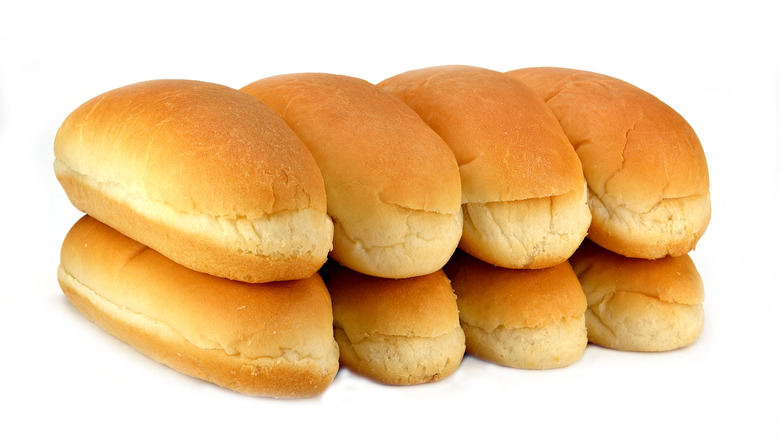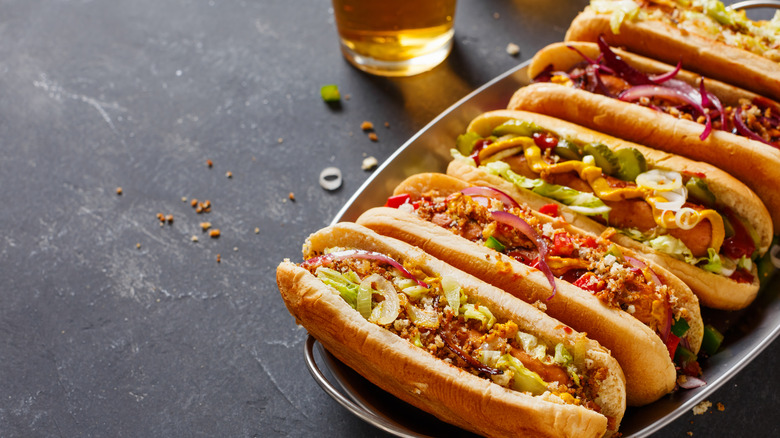12 Things You Shouldn't Do When Cooking Hot Dogs
Whether you just eat hot dogs on special occasions or are in a frankfurter hotbed like West Virginia — which scarfs 481 hot dogs per person each year according to USA Today, more than any other state — it all starts with how you prepare them. Franks may not exactly be prime rib or swordfish in terms of fanciness, but you still need to cook your hot dogs correctly to get the best taste. Not to mention the fact that like, with any meat, mistakes by the chef can lead to diners joining the 48 million Americans who come down with food poisoning every year (via the FDA).
And yet you may be making mistakes when cooking hot dogs that you didn't even realize. That's a big deal because hot dogs aren't just for Independence Day and Labor Day — they're a staple of the American diet. The National Hot Dog and Sausage Council (yes, it exists) estimates that 20 billion hot dogs are devoured in the U.S. every year. With Statista saying about 255 million Americans ate franks in 2020, that's more than 78 per person. Hot dogs are truly a worldwide sensation as well, with Market Data Forecast predicting the combined hot dog and sausage market will exceed $95 billion by 2027.
With that in mind, let's look at some things you should avoid when cooking frankfurters. By treating your hot dogs the right way, they'll feel even better in your belly.
1. Don't ignore food safety
As with any meat, handling and preparing hot dogs safely is paramount (via the USDA).
Although some of the same guidelines apply as with other meats, there are specific food safety tips for hot dogs, as well. Most importantly, even unopened packages are only safe to keep in the refrigerator for up to two weeks and at room temperature for two hours. And even though hot dogs are technically pre-cooked, you should get them steaming hot to kill off any lingering food bacteria. The USDA also recommends you don't freeze hot dogs for more than one to two months or their quality starts to drop — though Eat By Date says you can get away with four to six months.
A rotten hot dog will taste awful and can lead to you getting sick, but how do you tell if a hot dog has gone bad? Coleman Natural Foods says mold and discolorations are fairly certain visual signs of spoilage. Other indicators include a sour smell and a slimy feel. If the hot dogs are frozen, look for dull white patches, as these likely mean freezer burn. The best cooking techniques in the world won't save a hot dog that's beyond its shelf life.
2. Don't buy poor-quality hot dogs
A hot dog is a hot dog, right? Nope. Just as Chef's Resources lists 49 different cuts just of loin steak, there are lots of different wieners of varying quality. One thing complicating the search for high-quality hot dogs is that the term "hot dog" doesn't refer to what meat is used — per the National Hot Dog and Sausage Council, it's a take-off from when they were originally called "dachshund sausages" or "little-dog sausages."
As such, hot dogs can legally contain all sorts of meat. According to the USDA, a frank containing any varying combination of pork, beef, chicken, or turkey can be considered a hot dog, and that the product label has to say which meat(s) are in it. Furthermore, frankfurters can legally include up to 20% mechanically separated pork and an unlimited amount of mechanically separated poultry — which the European Food Safety Authority notes are the scraps left over after removing the main cuts of meat.
So perhaps it's not surprising that three of the top four picks by Consumer Reports are beef franks. Mechanically separated beef is banned for human consumption, so if you buy an all-beef hot dog, you're almost certainly getting higher-quality meat. The New York Times adds a good general rule is to look for short ingredient lists. The one exception is the "less than 2% of" section of the ingredient list, since these are the spices and other ingredients that help give a frankfurter its flavor.
3. Don't let the hot dogs split
Have you ever taken a hot dog off the grill or the stove and seen a big split in it? It might look interesting, but it's a bad sign. Belcampo Meat Co. butcher Jered Standing explains to Food Republic that when the casing splits on a hot dog or sausage, it's releasing the fat, juices, and other things that help it taste good. Also, the fat dripping down leads to flare-ups on a grill or stove that cause charring.
Knowing why a hot dog splits can help you prevent it from happening. Gizmodo says that scientifically speaking, these splits are caused by pressure buildup from both moisture vapor and food expansion. Since the casing doesn't expand as fast as the innards, it creates stress that eventually leads to a fissure.
Next is the question of how to combat this. Hofmann Sausage says the primary culprit for splitting is if you cover over too hot a temperature. Using medium heat will greatly reduce the chances of a frank bursting open. As for poking holes in the hot dog or scoring it, the experts are fittingly split. While Hofmann approves of this practice, Italian Barrel is against it, as you'll still be losing the juices in the end.
4. Not preparing the grill
Grilling is by far the preferred hot dog cooking method for Americans. A 2021 survey co-commissioned by the National Hot Dog and Sausage Council found 75% of respondents said grilling was their favorite way to cook hot dogs, with no other option even breaking double digits. But whether you're using a gas, charcoal, or electric grill, preparing it for a hot dog cookout is a must.
According to grill manufacturer Weber, the number-one secret is preheating your grill. Tossing hot dogs on a cold grill means they won't be at the optimal cooking temperature, which leads to improperly cooked or dried out franks. It also can cause food to stick to the grill grates and prevent it from searing — which is what creates those iconic grill marks. Finally, The Washington Post adds that preheating will sterilize the grill.
Along with preheating, you should clean the grill first to remove any debris or residue. You might also try coating the grates with cooking oil both before and after you cook. Known as seasoning the grill, Saber notes this process can reduce rust, contamination, and food sticking while making the grill easier to clean. Just like with any cooking appliance, preparation will yield a much better result.
5. Don't cook hot dogs over high heat
Another big hot dog cooking trap you can fall into is turning the heat up too high. In their official grilling instructions, Kingsford forewarns that hot dogs will burn fast if you're not careful. This may be due to how small they are compared to other meats — Kera News reports the standard size is 1.6 ounces, which means you'd need 10 hot dogs to make a pound.
The easiest way to avoid a burned-black hot dog is to turn the heat down. Coleman Natural Foods says the ideal temperature range is 250 to 325 degrees Fahrenheit, which is around the medium heat setting on most grills. Another recommendation courtesy of TheHotDog.org is to use indirect heat. This involves creating multiple "zones" with the meat placed in a different zone than where the heat is coming from (via MasterClass). You should also frequently turn the hot dogs or move them around as they cook to prevent burning, splitting, or drying out.
Remember that, since most hot dogs are pre-cooked, it doesn't take that long to grill them. Even using these cautious methods, a regular-size hot dog should only need five to seven minutes, with up to 15 minutes if you're grilling quarter-pound dogs. Avoid rushing and you'll be much happier with how they turn out.
6. Don't ignore the fat content
Although hot dogs may never be considered a "health" food, Consumer Reports observes they are much healthier now than in the past. Still, you should pay attention to a hot dog's fat content for multiple reasons. The USDA states that frankfurters can legally contain up to 30% fat, though this can vary greatly depending on the brand and meat. A standard all-beef hot dog has about 17 grams of total fat, per Livestrong. Even with the daily recommendations on total fat going up from 65 to 78 grams (via the FDA), that means one beef frank is still almost 22% of your daily value.
Conversely, poultry hot dogs are much lower in fat. For example, Ball Park Turkey Franks have 7 grams of fat each, less than half the 15 grams in Ball Park Original Beef Hot Dogs. The return risk is that, as discussed previously, poultry wieners can legally contain lower-grade mechanically separated meat.
But the flip side is that, for a variety of reasons, fattier foods simply taste better, as noted by "Fat Detection: Taste, Texture, and Post Ingestion Effects." The fat in a hot dog also affects the cooking process. Vincent's Meat Market explains that fat helps meat stay moist as it cooks, and thus lean meats are more likely to dry out. Therefore, if you go the low-fat hot dog route, you'll have to be more delicate.
7. Don't use a meat thermometer
A thermometer is considered a standard method of testing whether meat is fully cooked, so it's only logical to assume you would follow the same technique for the hot dog. But there are two reasons this isn't necessarily the case.
For starters, hot dogs count as a "Fully Cooked-Not Shelf Stable" food that is ready to eat (via the USDA). In other words, no further preparation is technically required — which means there are no official internal temperature requirements to follow. Second, Italian Barrel explains that poking holes in your hot dogs and sausages let the juices escape, and, well, when you're using a meat thermometer, you're sticking the probe directly into the food (via MasterClass). That means all your careful cooking and preparation can end up for naught.
Luckily, there are multiple ways to tell if hot dogs are done without poking them. TheHotDog.org says they're done when the frank has browned and is starting to curl. Hofmann Sausage adds to look for skin that is blistered just a little bit. Also, cook time is a great indicator. All but the largest hot dogs shouldn't need more than 10 minutes on the grill before they are hot and ready.
8. Avoid boiling the hot dogs if you can
When it gets too cold out to fire up the grill, it's tempting to fill a pot of water and toss a few hot dogs in. But no less an authority than Nathan's Famous says boiling hot dogs is a no-no. Doing so can cause the flavor to end up in the water instead of in the frankfurter. In advising food cart operators, Hot Dog Profits adds that hot dogs end up mushy if left in boiling water for too long.
It should be noted that boiling a hot dog isn't all food horror. KDVR notes boiling will plump your hot dogs for a fuller look, and it also lowers the salt content to make the frank healthier. Experts, though, would argue that these two benefits don't outweigh eating a soggy, flavorless hot dog (via Men's Health).
Nevertheless, if boiling is your only choice, there is a "right" way to do it. According to TheHotDog.org, bring the water to a boil, add the franks, and cook for four to five minutes. Any longer will significantly affect the taste and texture. Hot Dog Profits adds that, if you need to keep hot dogs warm, either set the holding water at 160 degrees Fahrenheit or move them to a steamer.
9. Don't cook every hot dog the same way
Although grilling is the tried and true method for cooking hot dogs, and boiling is considered a last resort, there are plenty of other options in between. Australian hot dog maker Yummy Dogs notes part of a frankfurter's magic is that it can be cooked and served pretty much any way you want.
So instead of getting set in your ways, experiment with how you prepare them. In addition to the methods already mentioned, hot dogs can be oven-roasted, pan-fried, and microwaved. Leave them whole when frying or cut them into pieces. Men's Health swears by a method known as "hydrotoasting," where you simmer the hot dogs in a pan of hot water — which eventually evaporates so you finish with a dry pan. Air Fryer Eats points out that you can use an air fryer, too. Other methods include steaming, poaching, and the heated rollers you might see at convenience stores and theaters (via The Guardian).
Different cooking methods produce different textures and tastes, so you're sure to find something your taste buds prefer on that particular day. You might even consider combining approaches, such as poaching the hot dog in a flavored liquid before grilling it. Ultimately, the only things limiting you are the available cooking appliances and the amount of time you have.
10. Don't forget about the buns
We've spent a lot of time on the hot dog itself, but the bun is crucial to the experience. After all, as written in "How the Hot Dog Found its Bun," hot dogs didn't really become an iconic food until they were served on buns. A practice purportedly begun in 1871 by Coney Island food cart operator Charles Feltman, the bun allowed people to bring their hot dogs anywhere.
Nowadays, many types of hot dog buns are available, and each makes its own contribution to the eating experience. So put some thought into what buns you're using. In addition to standard white buns, TheHotDog.org suggests possibilities such as Kaiser rolls, pretzel rolls, poppyseed rolls, and pizza bread. You also have a choice between a side-loading or a top-loading bun. Marketplace says although side-sliced buns are far more common, top-sliced buns are a better choice if you want to go hog-wild with condiments and toppings since these rolls are more structurally sound.
Finally, there's the debate of whether to toast or steam your frankfurter bun. Steaming a bun will make it soft and chewy — though you should only do this with denser rolls so they don't turn to mush (via TheHotDog.org). Toasting the bun gives it more taste and helps it hold up beneath the hot dog and toppings (via eHow). It's ultimately up to personal preference.
11. Don't be afraid to get creative with toppings
You've put the effort into selecting great-tasting hot dogs, cooking them carefully, and preparing the buns. But there's one more step: dressing it up. Cleveland.com notes that personalizing a hot dog with toppings is part of the fun. So why settle for an unadorned frankfurter?
The next question is what to put on your dog. Ketchup and mustard are the most synonymous with hot dogs and are also the most popular. A 2021 survey by the National Hot Dog & Sausage Council found that mustard was the top wiener condiment with 68% approval, followed by ketchup at 61%. But so many more options are out there. The same survey ranked onions neck-and-neck with ketchup, followed by relish, chili, and cheese. Condiment favorites vary by region, too. Sauerkraut ranks highest in the Northeast, while out West, mayonnaise and bacon are more popular.
And that's just scratching the surface. The Food Republic Hot Dog Style Guide cites 40 hot dog creations from around the world such as the Seattle, the Dodger Dog, the Colombia, and the Montreal (via Outdoors). On these franks, you might find jalapeño peppers, cream cheese, pineapples, cabbage, and even crushed potato chips. Try making one of these styles or come up with your own concoction. You just might fall in love with hot dogs all over again.
12. Don't enforce hot dog etiquette
You might not think a relatively simple, inexpensive food like the hot dog has official etiquette. But according to the National Hot Dog & Sausage Council, there are a lot of official "do's" and "don'ts." Some of the more notable suggestions are to serve hot dogs on paper plates, finish them in five bites or less, and never use ketchup if you're older than 18. Maple Leaf Foods has released a separate hot dog etiquette guide for Canadian frankfurter lovers which, among other things, says eating them with gloves and mittens is perfectly okay.
Some of the recommendations, like putting wet toppings on first, are useful. But others seem to be over-policing. Take the recommendation for adults not to use ketchup. The Council's rationale in the accompanying hot dog etiquette video is that "we all have to grow up sometime." Yet as Monterey County Now counters, the combination of a smoky grilled frank and sweet ketchup tastes pretty good.
We'll refer to Reader's Digest Canada on this, which says that whether or not you should feel ashamed of ketchup on a hot dog or other etiquette violations is up to you and you alone. So if you want to have ketchup, or wash your fingers instead of licking them, or take six bites to finish, go ahead. To each their own when it comes to frankfurters.
